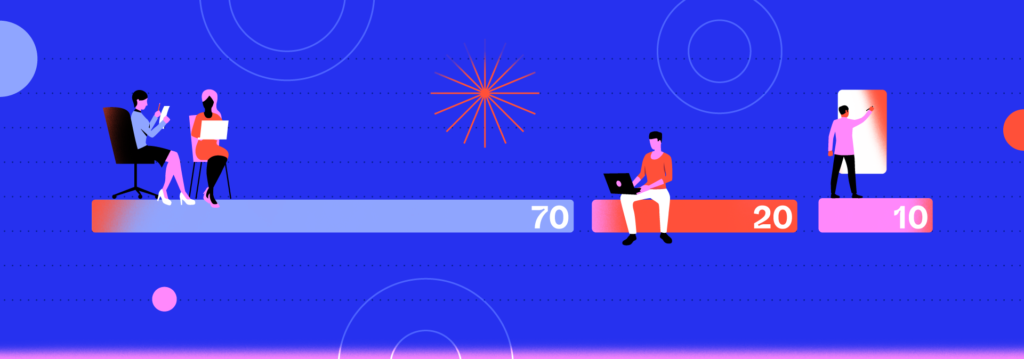Learning is essential for your company’s success. Up to 84% of corporate leaders view learning and investing in learning as a critical issue. However, despite the all-time high investment in training programs, the mismatch between learning in L&D as it exists and what leaders need is widening.
This begs the question: what learning system drives lasting behavioral change? Neuroscience studies show that we learn and retain most through visceral, lived experiences that best activate our emotional circuits. Simply put: experience is the number one way people learn.
The 70:20:10 model of learning embodies precisely that — learning by doing, or experiential learning. Let’s look at what the 70:20:10 model entails and why companies rapidly shift from formal training to informal (on-the-job) experiences.
What Is The 70:20:10 Rule?
The 70:20:10 rule is a Learning & Development model that presents the different ways people learn in the workplace.
This learning model breaks down the barrier between what employees learn and what they do in the workplace. The core of the approach is to shift the training model from formal (classroom) training to performance-based or on-the-job (informal) training.
The 70:20:10 model in a nutshell
According to the Center for Creative Leadership (CCL) and their Lessons of Experience research, the 70:20:10 model proposes that:
- 70% of learning is experiential – it comes from job-related experiences and assignments. From daily tasks to challenges and practice, experiential learning allows employees to learn through on-the-job experiences.
- 20% of learning is social – it comes from developmental relationships with co-workers, mentors, managers, and other influential employees within an organization. Social learning allows the employee to learn by completing tasks and challenges with and through others.
- 10% of learning is formal – it comes from formal coursework and training, like content, interactive videos, and lessons or webinars.
The Importance of The 70% | Why Experiential Learning Is The New Graduate Degree
The 70:20:10 rule shows us that learning exists within an ecosystem. Part 70% of this model focuses on learning through direct participation, immediate feedback, and support. This learning happens through completing daily tasks and “heat experiences” or challenges.
Experiential learning puts the employee in new and uncertain situations or challenging assignments. Challenging assignments — commonly known as stretch assignments — are the heart of the 70% part of this method. They are carefully designed and executed to drive learning in the organization. Through them, the employee is introduced to a new project that broadens the scope of their role.
A challenging assignment puts the employee in a position where they have to tackle a broad or unfamiliar task and work with diverse sets of people. It allows the employee to learn through trial and error and develop a new skill set and deeper expertise over time.
How to Implement The 70:20:10 Model for Learning and Development
History of the 70:20:10 Rule
The 70:20:10 model for Learning & Development was originally introduced by the Center for Creative Leadership (CCL) in the 1980s. It’s based on the work of Morgan McCall, Robert Eichinger, and Michael Lombardo that studied how executives learn, grow and change in their careers.
The surprising revelation of the study was that despite the tens of billions companies spend on employee training each year, executives didn’t credit this as a critical element for learning leadership qualities. Instead, they praised on-the-job experiences, challenging assignments, and mentoring as their primary source for learning and developing leadership traits.
Facts & Stats That Support the 70:20:10 Method
- A survey by Brandon Hall Group found that adopting the 70:20:10 model allowed organizations to significantly increase the use of informal learning. By doing so, organizations have seen a significant improvement between learning and individual and organizational performance.
- The Best Companies for Leadership survey revealed that the top 20 companies (including General Electric and Coca-Cola) use experience-driven development and a structured approach to develop their talent.
- According to studies, stretch assignments (challenging tasks) and on-the-job learning have a positive impact on employee performance. The Corporate Executive Board revealed that managers rate on-the-job learning as three times more impactful on employee performance compared to formal training programs [1].
- A 2018 report from LinkedIn found that 94% of employees would stay at a company longer if the company invested in their careers. This shows that employees want to gain more on-the-job learning opportunities.
- According to research by GoodPractice, 55% of managers will use trial and error at least once a month as an effective way to learn when facing a workplace challenge.
Companies are rapidly shifting from part 10% to part 70%
During this critical time when the gaps in formal education needs widen, employers have started equipping their workforce with skills needed to make use of new and current technologies.
Amazon has set out $700 million to retrain a third of its U.S. workforce by 2025. They are using training as a powerful tool to prepare employees for a more automated future. Many organizations are reluctant to invest in training or retraining their workforce for future demands.
But, numbers show that hiring and retaining employees is almost always cheaper than hiring new talent. The cost of rehiring and onboarding new employees can add up to 150% of the employee’s annual compensation. On the other hand, the return on investment in education is massive because it dramatically improves on-the-job productivity and efficiency. And, there are many ways you can measure progress.
Ready to make the switch?
Journey App allows you to build and develop your team’s 70:20:10 method. Journey’s Employee Development roadmap is designed to provide actionable guidance and continuous follow-up that helps managers refine the team’s must-have skills. With Journey, you can rapidly plan, develop, execute, and evaluate employee development success. Book your demo now.
If you want to learn more about employee development, you can check out our blog posts here.

